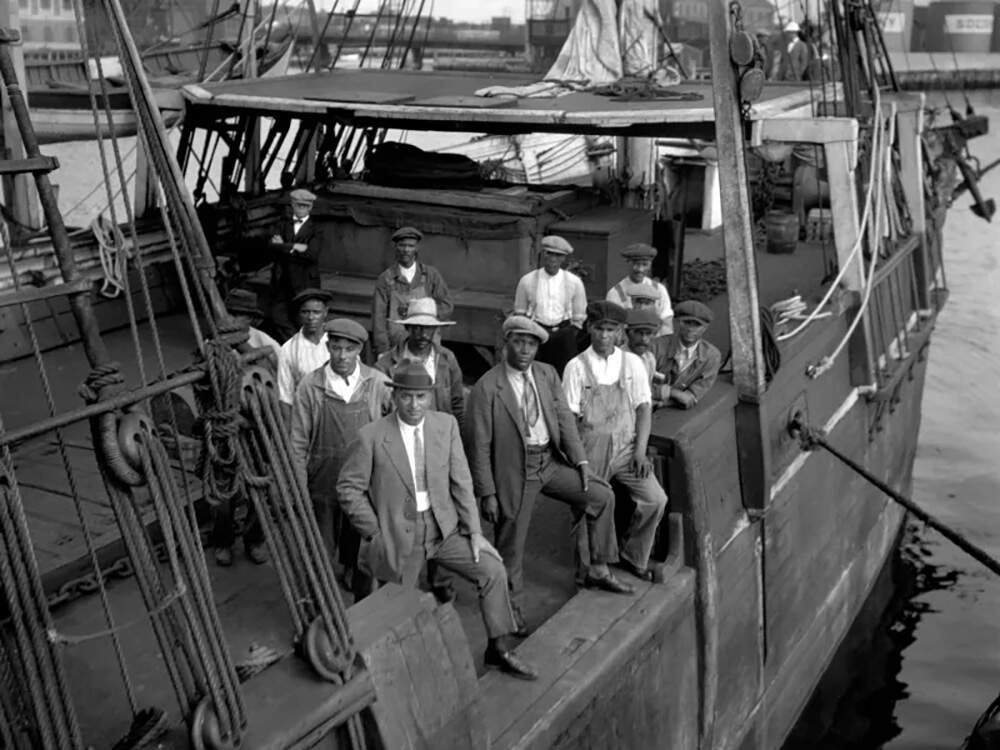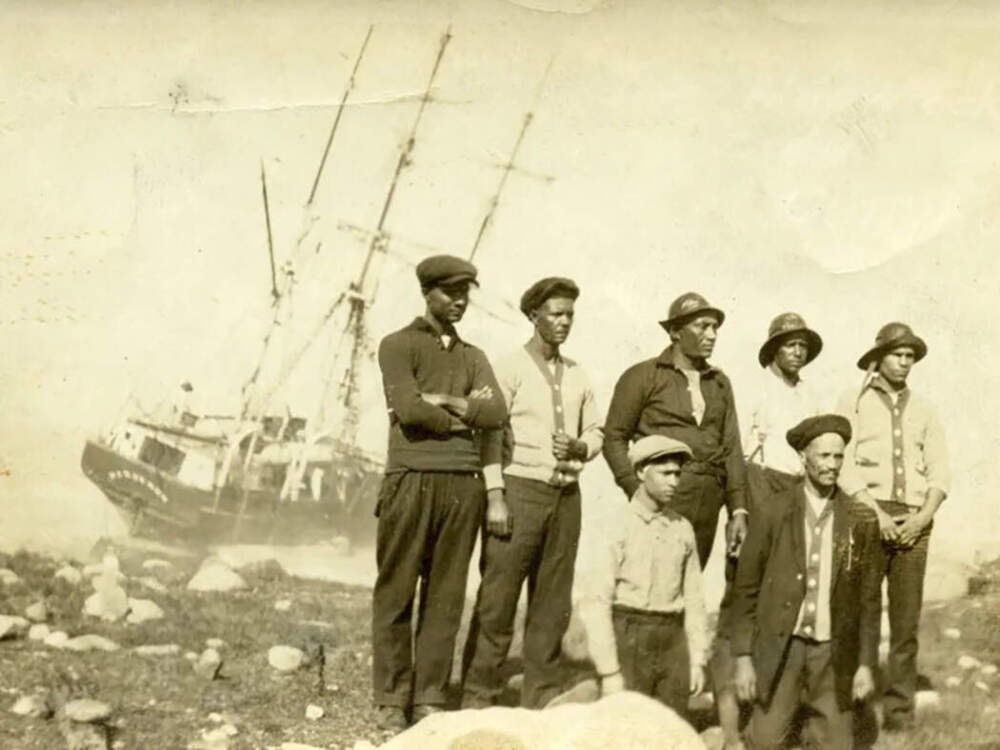Advertisement
Remembering the wreck of New Bedford’s last great whaleship

Contrary to the motto on its municipal seal, New Bedford was no longer the city that lit the world by the 1920s.
America’s lamps mostly ran on electricity and kerosene. Whale byproducts still had some commercial uses: The oil served as a base for various face creams and machine lubricants, ambergris was a fixative in perfumes, and salesmen tried promoting whale meat as a cheap dietary alternative.
But the industry that created so many of New England’s founding fortunes had all but disappeared. New Bedford’s peak fleet of about 350 whaling ships had dwindled to just a few boats, some of which were picking up extra income as movie props.
The Wanderer, the last of New Bedford’s square-rigged whaleships, whose wreck would soon serve as a symbolic death for the city’s whaling industry, was one of those handsome ships in the movies. The 116-foot bark stars in the 1922 silent film Down to the Sea in Ships, which even then was promoted as an homage to a lost way of life. The movie features footage of an authentic whale hunt, but it was unclear if the Wanderer would ever go whaling again after production wrapped.
“It was predicted by the papers that it would probably be sold to a motion picture company or something,” said Connor Gaudet, a curator at the Mattapoisett Museum.
The museum has an exhibit up until next summer exploring the ways people have kept the memory of the Wanderer alive. One of the items Gaudet displays is a cot from the Wanderer that a local family kept around for their children’s sleepovers throughout the 2010s. The exhibit features paintings, pieces of the ship, and even a postcard from a cocktail bar in midtown Manhattan that was built to look like the inside of the Wanderer.
Gaudet said the Wanderer remains a powerful symbol because it inspires nostalgia for an era when coastal New Englanders created their wealth through a dangerous battle with the ocean. The Wanderer, built in 1878, was the last whaleship made in Mattapoisett before it became the summer community it is today.
“Whaling was 20 years past its prime,” Gaudet said, “so in a sense, it was kind of a miracle she was made.”
The Wanderer proved to be a resilient ship, making 23 whaling voyages in a 46-year career and landing more than 900,000 gallons of oil. She survived an attack from an aggressive whale in the Caribbean; she was iced into the Arctic Ocean several times; and she dodged German submarines during World War I. Some scholars, including the former curator at the New Bedford Whaling Museum, William H. Tripp, suspect that in 1917 the Wanderer landed the largest-ever cargo of whale oil for a single trip.
Advertisement
The captain for many of these adventures was Antone Edwards, an immigrant from the island of Flores in the Azores who first joined the crew of a New Bedford whaler in 1898 at 16 years old. Edwards finally got an ownership stake of the Wanderer in 1920, after the city’s Yankee aristocracy had mostly abandoned the industry.
“Antone Edwards didn’t have the infrastructure to set up an oil derrick in Pennsylvania. He was a whaling captain,” Guadet said. “He was a whaling captain. So, you know, he just kept on going out until he was no longer able to make a profit.”

Edwards didn’t last long as a ship owner though. By 1924, he was telling newspaper reporters that the Wanderer was gearing up for what would probably be its last voyage — and perhaps the last voyage of any whaleship in New Bedford.
Edwards tried to round up willing sailors for the trip, but on the day the Wanderer was supposed to set sail, Edwards only had a skeleton crew. A traditional sea service was still held for the ship’s departure.
The organ from the Seamen’s Bethel, which is still in use today, was wheeled onto the Wanderer for a round of hymns. Hundreds of people crowded onto Pier 3 to send off the ship. But the voyage had problems from the start: the ship left her cat onshore and Captain Edwards wasn’t really ready to go, even as a tugboat pulled the Wanderer out of the harbor.
After anchoring the Wanderer near Mishaum Point in Dartmouth, Captain Edwards hopped back on the tugboat to New Bedford, where he may have been recruiting more deckhands at the last minute or processing immigration paperwork for his Cape Verdean crew.
While Edwards was away, an unexpected storm blew in.
“August 26 1924 will be a day long remembered in New Bedford for on that day, one of the worst storms in the memory of old timers swept the city,” a local publisher said at the time in a short book about the storm. “Not since 1869 had there been a tempest to compare with it.”
Newspapers reported 60 mile-an-hour winds and 15-foot waves within Buzzards Bay, an astounding height for such a sheltered body of water. The force from the gale snapped one of the Wanderer’s two anchors and dragged the ship roughly seven miles across the bay until she struck the Middle Ground shoal near Cuttyhunk.
It was near the shoals that the Wanderer’s crew decided to abandon ship in two of the smaller boats typically used for approaching whales at close range and harpooning them.
One boat made it safely to shore on Cuttyhunk. The other disappeared for a night before it was rescued by a lightship stationed near the dangerous Sow and Pigs reef.
Everyone survived in the end, except the Wanderer, which ran aground on Cuttyhunk totally ruined. A salvage company came to scrap the Wanderer for valuable parts the next day.

Some of the ship’s wood became a commemorative cabinet in a bank president’s office at the State Street Trust Company in Boston. The ship’s mast became a flagpole in Mattapoisett town center. Its figurehead, a golden eagle, wound up at the New Bedford Whaling Museum.
Cuttyhunkers, who often risked their lives to save shipwrecked sailors, also grabbed what they could from the Wanderer. Trypots meant for boiling blubber became planters that still decorate a private garden on the island today. An oar pilfered from the Wanderer hangs in the rafters at the Cuttyhunk Fishing Club. Captain Edwards’ chair is on Cuttyhunk too, inside a private home.
Allie Thurston, a volunteer at the Cuttyhunk Historical Society, said other items salvaged from the Wanderer will likely be kept as secrets by island residents.
“They don’t want you to know the treasures they have,” Thurston said. “They’re treasures that belong on the island.”
Captain Edwards only kept a few keepsakes for himself, which were passed down through his family following his death after a car accident in 1936.
George Alexander, his grandnephew, said he inherited Edwards’ brass knuckles and a lamp made from one of the ship’s pulleys. Alexander, who still lives in New Bedford, said Captain Edwards used to visit his mother’s house and tell stories about the Wanderer.
“He came one time, and he was still upset about losing the ship,” Alexander said. “He came over with some gold coins, and he sort of tossed the gold coins and said, ‘This is all that’s left. This is all that’s left.’”
There’s one important detail that’s been lost in all the lore though: the Wanderer wasn’t the last whaleship to leave New Bedford. It was only the last of the square-rigged whaleships, the kind immortalized in Moby Dick that could sail for four to five years at a time. Smaller ships like the John R. Manta kept making short whaling trips from New Bedford until 1927.
Still, for many people, the Wanderer’s dramatic wreck is just too fitting of an ending to pass up for such a legendary industry. Who doesn’t like to go out with a bang?
This story is a production of the New England News Collaborative. It was originally published by The Public's Radio.